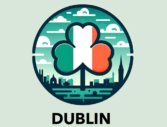Visit some of Dublin’s unique and fascinating attractions that are key to the character of Dublin city, but also to its people and the people of Ireland
Guinness Store House
Guinness Storehouse is a tourist attraction at St. James’s Gate Brewery in Dublin, Ireland.Since opening in 2000, it has received over twenty million visitors.
The Storehouse covers seven floors surrounding a glass atrium shaped in the form of a pint of Guinness. The ground floor introduces the beer’s four ingredients (water, barley, hops and yeast), and the brewery’s founder, Arthur Guinness. Other floors feature the history of Guinness advertising and include an interactive exhibit on responsible drinking. The seventh floor houses the Gravity Bar with views of Dublin and where visitors may drink a pint of Guinness included in the price of admission.
The old Jameson Distillery
The original distillery on this site was called the Bow Street Distillery and was established in 1780. John Jameson took full ownership (he was previously the general manager) and expanded the distillery in 1805. By 1810, the operation was officially renamed to John Jameson & Son’s Bow Street Distillery. The distillery grew to an upwards of 5 acres (2 ha) by 1886.
At this time, it was described by many as a “city within a city”. The distillery also housed a Smithy, Cooperage, saw mills, engineers, carpenters, painters and coppersmiths’ shops. Water for the distillery came from two deep wells dug underneath the site. Cellars were also dug underneath nearby streets to store maturing whiskey, while four stills and two wash stills, each holding 24,000 gallons (109,000 L), were heated by both fire and steam coils above.
Following a difficult period that included American Prohibition, Ireland’s trade war with Great Britain, and the introduction of Scotch blended whiskey, the Jameson distillery fell on hard times and decided to form the Irish Distillers Group with their previous rivals, the Cork Distilleries Company and John Power & Son in 1966. Eventually, it became one of the last distilleries in Ireland to close in 1971. The operation was then moved out of Dublin to the New Midleton Distillery.
Glasnevin cemetery
Glasnevin Cemetery (Irish: Reilig Ghlas Naíon) is a large cemetery in Glasnevin, Dublin, Ireland which opened in 1832. It holds the graves and memorials of several notable figures, and has a museum.
The cemetery is located in Glasnevin, Dublin, in two parts. The main part, with its trademark high walls and watchtowers, is located on one side of the road from Finglas to the city centre, while the other part, “St. Paul’s,” is located across the road and beyond a green space, between two railway lines.
The cemetery contains historically notable monuments and the graves of many of Ireland’s most prominent national figures. These include the graves of Daniel O’Connell, Charles Stewart Parnell, Michael Collins, Éamon de Valera, Arthur Griffith, Maude Gonne, Kevin Barry, Roger Casement, Constance Markievicz, Pádraig Ó Domhnaill, Seán MacBride, Jeremiah O’Donovan Rossa, James Larkin, Brendan Behan, Christy Brown and Luke Kelly of the Dubliners.
The National Botanic Gardens
The National Botanic Gardens (Irish: Garraithe Náisiúnta na Lus) is a botanical garden, located in Glasnevin, 5 km north-west of Dublin city centre, Ireland.The 19.5 hectares are situated between Glasnevin Cemetery and the River Tolka where it forms part of the river’s floodplain.
The gardens were founded in 1795 by the Dublin Society (later the Royal Dublin Society) and are today in State ownership through the Office of Public Works. They hold approximately 20,000 living plants and many millions of dried plant specimens. There are several architecturally notable greenhouses. Today the Glasnevin site is the headquarters of the National Botanic Gardens of Ireland which has a satellite garden and arboretum at Kilmacurragh in County Wicklow.
Croke Park
Croke Park (Irish: Páirc an Chrócaigh) is a Gaelic games stadium located in Dublin, Ireland. Named after Archbishop Thomas Croke, it is sometimes called Croker by GAA fans and locals. It serves as both the principal stadium and headquarters of the Gaelic Athletic Association (GAA). Since 1891 the site has been used by the GAA to host Gaelic sports, including the annual All-Ireland in Gaelic football and hurling.
James Joyce Centre
The James Joyce Centre is a museum in Dublin, Ireland, dedicated to promoting an understanding of the life and works of James Joyce.
The Centre is situated in a restored 18th-century Georgian townhouse at 35 North Great George’s Street, Dublin, dating from a time when north inner city Dublin was at the height of its grandeur.
Mountjoy square
Mountjoy Square (Irish: Cearnóg Mhuinseo) is a Georgian garden square in Dublin, Ireland, on the north side of the city just under a kilometre from the River Liffey. One of five Georgian squares in Dublin, it was planned and developed in the late 18th century by the Luke Gardiner, 1st Viscount Mountjoy. It was surrounded on all sides by terraced, red-brick Georgian houses. Construction began in the early 1790s and the work was completed in 1818.
From: https://lovetovisitireland.com/dublin-north-side-attractions/
From Social Media: –
And.. From Instagram
A video featuring footage of a County Mayo Dad being consumed by fits of laughter while trying to record a birthday message for his son, has gone viral.

Top 10 Things you must do in DUBLIN, Ireland
Dublin has so much to offer anyone visiting the city. From traditional music and dance, festive Irish pubs, castles, history and culture, plus the heritage of Irish Whiskey and the story of Guinness – there is something for everyone. Known as one of the friendliest cities in the world, you may even make an Irish friend of two!
Read more: – https://lovetovisitireland.com/top-10-things-you-must-do-in-dublin-ireland/
Ready for your trip to Ireland? Start here.

->








